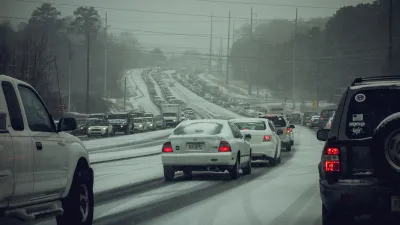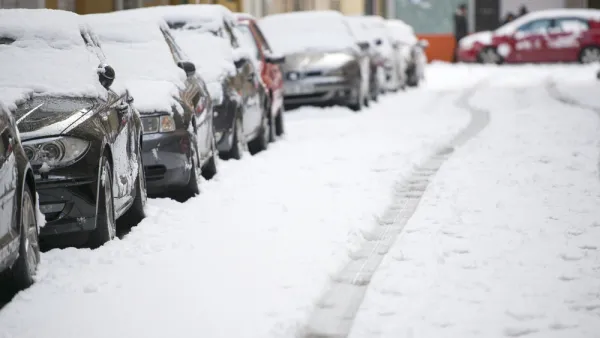You can point the finger at unprepared politicians or mistaken meteorologists for paralyzing Atlanta this week. But to find the real culprits, you'll have to look at the region's history of land use and transportation decisions, argues Rebecca Burns.

Meteorologists and public officials have been blamed for causing the "rush hour from hell" that stranded drivers on Atlanta area roadways and others in their schools, homes, and workplaces Tuesday evening. But for Rebecca Burns, the true causes of the disaster were decades in the making.
"What happened in Atlanta this week is not a matter of Southerners blindsided by unpredictable weather," she writes. "More than any event I’ve witnessed in two decades of living in and writing about this city, this snowstorm underscores the horrible history of suburban sprawl in the United States and the bad political decisions that drive it. It tells us something not just about what’s wrong with one city in America today but what can happen when disaster strikes many places across the country."
She examines four factors that turned a light snowfall into a regional catastrophe:
- Atlanta’s patchwork of local governments
- Auto-oriented development
- History of inadequate transit investment
- Rejection of a transportation sales tax referendum in 2012
"If Atlanta, the region, wants to get serious about public safety, its mayors, county officials, and state officials will need to start practicing regionalism instead of paying lip service to it," Burns concludes. "And whether threatened by a dangerous pandemic, a major catastrophe, or just two inches of snow, we need to have ways to get around—and out of—the city other than by car."
FULL STORY: The Day We Lost Atlanta

National Parks Layoffs Will Cause Communities to Lose Billions
Thousands of essential park workers were laid off this week, just before the busy spring break season.

Retro-silient?: America’s First “Eco-burb,” The Woodlands Turns 50
A master-planned community north of Houston offers lessons on green infrastructure and resilient design, but falls short of its founder’s lofty affordability and walkability goals.

Delivering for America Plan Will Downgrade Mail Service in at Least 49.5 Percent of Zip Codes
Republican and Democrat lawmakers criticize the plan for its disproportionate negative impact on rural communities.

Test News Post 1
This is a summary

Test News Headline 46
Test for the image on the front page.

Balancing Bombs and Butterflies: How the National Guard Protects a Rare Species
The National Guard at Fort Indiantown Gap uses GIS technology and land management strategies to balance military training with conservation efforts, ensuring the survival of the rare eastern regal fritillary butterfly.
Urban Design for Planners 1: Software Tools
This six-course series explores essential urban design concepts using open source software and equips planners with the tools they need to participate fully in the urban design process.
Planning for Universal Design
Learn the tools for implementing Universal Design in planning regulations.
EMC Planning Group, Inc.
Planetizen
Planetizen
Mpact (formerly Rail~Volution)
Great Falls Development Authority, Inc.
HUDs Office of Policy Development and Research
NYU Wagner Graduate School of Public Service



























